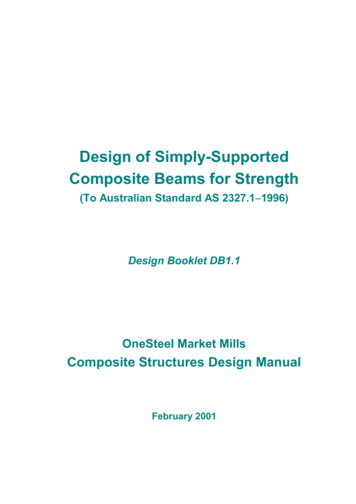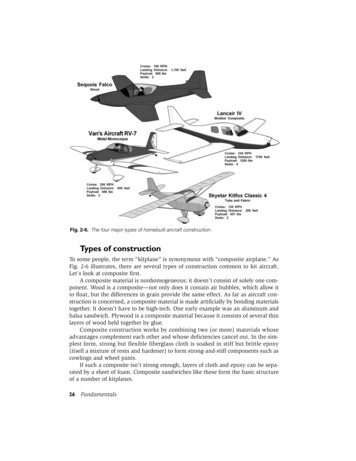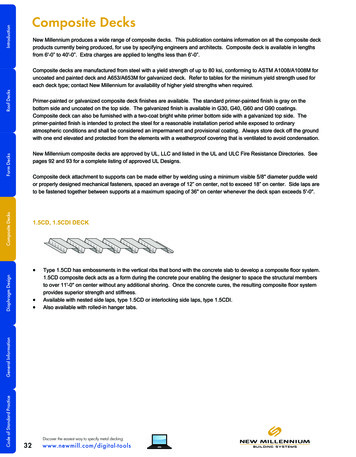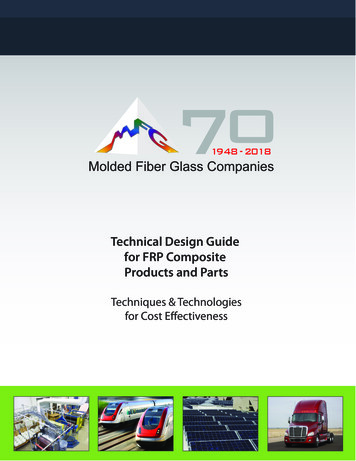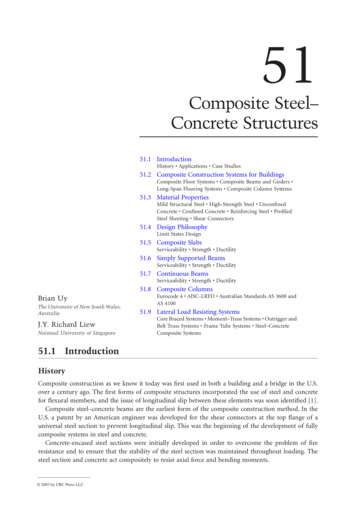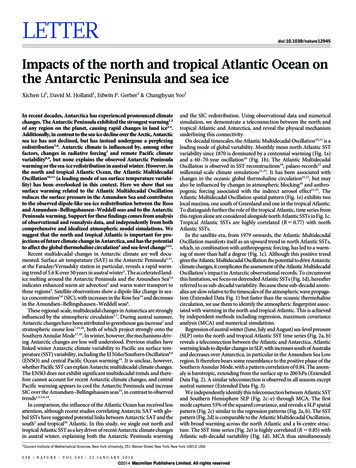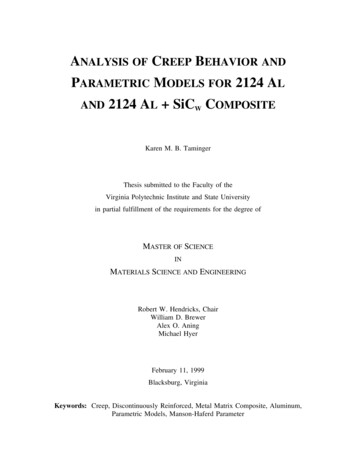
Transcription
ANALYSIS OF CREEP BEHAVIOR ANDPARAMETRIC MODELS FOR 2124 ALAND2124 AL SiCW COMPOSITEKaren M. B. TamingerThesis submitted to the Faculty of theVirginia Polytechnic Institute and State Universityin partial fulfillment of the requirements for the degree ofMASTER OF SCIENCEINMATERIALS SCIENCE AND ENGINEERINGRobert W. Hendricks, ChairWilliam D. BrewerAlex O. AningMichael HyerFebruary 11, 1999Blacksburg, VirginiaKeywords: Creep, Discontinuously Reinforced, Metal Matrix Composite, Aluminum,Parametric Models, Manson-Haferd Parameter
ANALYSIS OF CREEP BEHAVIOR ANDPARAMETRIC MODELS FOR 2124 ALAND 2124 AL SiCW COMPOSITEKaren M. B. Taminger(ABSTRACT)The creep behavior of unreinforced 2124 aluminum and 2124 aluminum reinforced with15 wt% silicon carbide whiskers was studied at temperatures from 250 F to 500 F.Tensile tests were conducted to determine the basic mechanical properties, andmicrostructural and chemical analyses were performed to characterize the startingmaterials. The creep, tensile, and microstructural data for the 2124 SiCw composite werecompared with a similarly processed unreinforced 2124 aluminum alloy. Applying thebasic theories for power law creep developed for common metals and alloys, the creepstress exponents and activation energies for creep were determined from the experimentaldata. These results were used to identify creep deformation mechanisms and comparedto predicted values based on a parametric approach for creep analysis. The resultsdemonstrate the applicability of traditional creep analyses on non-traditional materials.
ACKNOWLEDGEMENTSThere are numerous people who were instrumental in assisting me to finally completethis degree.First, I would like to thank my committee chairman, Dr. Robert W.Hendricks for his guidance and enthusiasm for my research. I would like to thank mycommittee, Dr. Robert W. Hendricks, Dr. Michael W. Hyer, Dr. Alex O. Aning, and Mr.William D. Brewer for having faith in my abilities, for being willing to tackle a graduatestudent from 300 miles away, and for exercising infinite patience with my timetable. Iwould also like to thank Mr. William D. Brewer of NASA Langley Research Center forserving as a mentor as well as an adjunct advisor for this degree, (even though hepreferred a root canal to my defense). This degree would never have materialized (nopun intended) without the help of Ms. Jan Doran in the Materials Engineering Departmentat VPI&SU, who rescued my student file from certain oblivion on several occasions. Mygratitude is also extended to Mr. George Allison of NASA Langley Research Center forhis assistance with the tuition side of this degree. Finally, I would be remiss in failingto mention my husband, Brian, for all of his love and support, for picking up more thanhis share of the slack so that I could work on this thesis, and for always helping me tosee the hope of a rainbow through a little black rain cloud.iii
CONTENTSABSTRACT.ii.iii1 INTRODUCTION .1.1 Development of Airframe Applications.1.2 Materials and Properties.1.3 Creep Degradation Mechanisms and Parametric Models.127172 THESIS JUSTIFICATIONACKNOWLEDGEMENTS.26.3 PROCEDURES3.1 Experimental Design.3.2 Material and Processing History3.3 Microstructural Analysis.3.4 Phase Identification .3.5 Tensile Tests.3.6 Creep Tests .272728313335384 DISCUSSION OF RESULTS4.1 Microstructural Analysis4.2 Tensile Data .4.3 Creep.4.4 Predictive Creep 94.1455 CONCLUSIONSA DEFINITION OF SYMBOLSB TENSILE DATA.146C CREEP DATA.159.202VITA.iv
TABLE OF CONTENTSLIST OF TABLES1Alloy compositions for 2024 and 2124.762Test matrix. .773Tensile data for unreinforced 2124.814Tensile data for 2124 SiCw.835Creep data for unreinforced 2124. .866Creep data for 2124 SiCw. .877Creep stress exponents for unreinforced 2124 and 2124 SiCw.898Activation energies for creep for unreinforced 2124 and 2124 SiCw.909Manson-Haferd parameter values for unreinforced 2124and 2124 SiCw.91Manson-Haferd predictions of creep stress exponents forunreinforced 2124 and 2124 SiCw.92Manson-Haferd predictions of activation energies for creep for.unreinforced 2124 and 2124 SiCw.931011.v
TABLE OF CONTENTSLIST OF FIGURES1Skin temperature of a supersonic aircraft as a function of airspeed.982Thermal flight profile for a standard mission on the Concorde. .993Creep deformation-mechanism map for pure aluminum. .1004Optical micrographs of unreinforced 2124 and 2124 SiCw.1015SEM micrograph of polished cross-section of 2124 SiCw.1026TEM micrographs of 2124 SiCw after 143 hrs at 350 F/35 ksi. .1037X-ray diffraction scans of as-received unreinforced 2124 and2124 SiCw. .1048Al-Si binary phase diagram.1059X-ray diffraction scan of 2124 SiCw as-received and after 142 hoursat 350 F with 0 and 35 ksi.10610Typical stress-strain curve for 2124 SiCw at 300 F.10711Typical room temperature stress-strain curve for unreinforced 2124.10812Effect of temperature on ultimate tensile strength.13Effect of temperature on proportional limit.14.109.110Effect of temperature on 0.02% offset yield strength.11115Effect of temperature on modulus. .11216Strain gage information sheet.11317Creep of unreinforced 2124 and 2124 SiCw at 250 F and 37 ksi.11418Creep of unreinforced 2124 and 2124 SiCw at 350 F and 25 ksi.11519Creep of unreinforced 2124 and 2124 SiCw at 500 F and 17 ksi.11620Creep of unreinforced 2124 and 2124 SiCw at 350 F and a stressratio of 0.5. .11721Creep of 2124 SiCw at 350 F and 17, 25, and 35 ksi.11822Creep of unreinforced 2124 at 350 F and 17, 25, and 35 ksi.119.vi.
23Creep of 2124 SiCw at 17 ksi and 350 F and 400 F.2425.120Creep of unreinforced 2124 at 17 ksi and 350 F and 400 F.121SEM fractographs of 2124 SiCw tensile specimens tested at300 F and 500 F. .12226Determination of creep stress exponents for 2124 SiCw. .12327Determination of creep stress exponents for unreinforced 2124. .12428Effect of temperature on stress exponents for 2124 SiCw.12529Effect of temperature on stress exponents for unreinforced 2124.12630Determination of creep threshold stress for 2124 SiCw. .12731Determination of creep threshold stress for unreinforced 2124. .12832Determination of apparent activation energy for creep for 2124 SiCw. .12933Determination of apparent activation energy for creep forunreinforced 2124. .130Determination of Larson-Miller constant based on minimumcreep rate for 2124 SiCw. .131Determination of Larson-Miller constant based on minimumcreep rate for unreinforced 2124. .132Determination of Manson-Haferd constants based on time to.0.05% strain for 2124 SiCw.133Determination of Manson-Haferd constants based on time to0.05% strain for unreinforced 2124.134Determination of Manson-Haferd constants based on minimumcreep rate for 2124 SiCw. .135Determination of Manson-Haferd constants based on minimumcreep rate for unreinforced 2124. .13640Manson-Haferd master curves for time to 0.05% creep strain.13741Manson-Haferd master curves for minimum creep rate. .13842Manson-Haferd predictions of creep stress exponents for 2124 SiCw.13943Manson-Haferd predictions of creep stress exponents forunreinforced 2124. .140343536373839vii.
44454647Effect of temperature on predicted creep stress exponents for2124 SiCw. .141Effect of temperature on predicted creep stress exponents forunreinforced 2124. .142Manson-Haferd predictions of creep activation energies for.2124 SiCw. .143Manson-Haferd predictions of creep activation energies forunreinforced 2124. .144viii
TABLE OF CONTENTSLIST OF EQUATIONS1Standard equation for simple power law creep.212Basic equation for Larson-Miller parametric approach.233Basic equation for Manson-Haferd parametric approach. .244Origin of power law creep equation, based on dislocation theory.505Temperature dependence of creep stress exponent for 2124 SiCw.526Temperature dependence of creep stress exponent forunreinforced 2124. .527Power law creep with a threshold stress. .538Power law creep adapted for effect of temperature on modulus. .549Relationship between creep and apparent activation energies.5410Components of creep activation energy.5511Definition of apparent activation energy for creep.5512Definition of modulus component of activation energy for creep.5513Empirical curve fit to master curve for time to 0.05% strainin unreinforced 2124.61Empirical curve fit to master curve for time to 0.05% strainin 2124 SiCw.61Empirical curve fit to master curve for minimum creep ratein unreinforced 2124.63Empirical curve fit to master curve for minimum creep ratein 2124 SiCw.63141516ix.
CHAPTER 1INTRODUCTIONWhiskers have been added to some aluminum alloys to enhance the alloys' room andelevated temperature properties. However, the creep properties of whisker reinforcedcomposites are not well understood.Thus, it is of interest to determine the creepproperties and mechanisms in whisker reinforced aluminum. It is impractical to performcreep tests for the entire projected lifetime of real-life applications, particularly when thelifetimes can range from 20,000 to 120,000 hours. Therefore, determining an acceptable,conservative method for extrapolating long term properties from short term tests is asignificant goal. The data also must be presented to the structural designers in a formatwhich is easy to understand and use.The objectives of this research program were threefold. First, the creep propertieswere measured for 2124 SiCw over a temperature range of 250 F to 500 F. Creep wasalso performed on unreinforced 2124 as a baseline. Second, creep parameters of stressexponent and activation energy for creep were calculated based on the empirical data.This information was used to deduce the active damage mechanisms for creep. Third, thecreep data were extrapolated using a parametric model for creep. An appropriate creepparametric model, the Manson-Haferd model, was selected to extrapolate the experimentaldata. Error analysis has been performed to give a reliability factor to the extrapolateddata.There are many markets for aluminum alloys, such as the aircraft, automobile, andaerospace industries. Commercial subsonic aircraft operate in a temperature regime inwhich creep is not a significant problem. (Collins, 1981; Dieter, 1986) However, with1
Karen M. B. TamingerCHAPTER 1. INTRODUCTION2the increasing demand for air travel over long distances, such as across the Atlantic orPacific Oceans, the demand to push civil transport capabilities into the supersonic regimehas also increased. The increase in temperature associated with these supersonic speedshave brought an entire new problem to the design of airframe structures. In the aerospaceand defense industries, rocket and missile fins require high stiffness and resistance to hightemperatures for short periods of time. As the automobile industry competes to reduceweight and improve fuel-efficiency, durable, lightweight materials for elevatedtemperature applications in engines are necessary. Increasing the temperatures in theengine components and reducing the total weight of the automobiles will both impact thefuel efficiency. As can be seen, there are numerous demands for improved materials foruse in elevated temperature environments in many different industries.1.1DEVELOPMENT OF AIRFRAME APPLICATIONSLeonardo da Vinci, although he lived nearly four centuries before humans evertraveled in a flying machine, understood the importance of material selection for use inaircraft. In 1505, da Vinci wrote, "Its joints should be of strong tanned leather and itssinews of raw silk of great strength; and let not anyone hamper himself with fittings ofiron, because they burst easily in twisting, or waste away, for which reasons they are notto be used," regarding construction materials for his flying machine. (Murphy, 1972) DaVinci recognized the most important properties of the times for structural design werestrength and weight. He also recognized there are additional properties that are importantand may exclude the use of some materials with otherwise good properties, as in the weaktorsion and corrosion tendencies of iron and steel. This philosophy in material selectionis still being used today in mechanical and structural design.Humans have always dreamed of flying, and materials issues have always been anintegral part of this desire to design and build flying machines. In Ancient Greek
Karen M. B. TamingerCHAPTER 1. INTRODUCTION3mythology, Daedalus fabricated wings from wax and goose feathers for himself and hisson, Icarus, to escape from the Labyrinth by flying. (Hamilton, 1942) In 1505, da Vincirecommended the use of leather and silk for the joints of his flying machine. Threehundred years later, Sir George Cayley, a British aerodynamicist, suggested that bamboohad properties that would be excellent for aerial navigation purposes. It is only naturalthen that when the first flying machines did emerge, they were built of common rawmaterials : wood and canvas -- from the lighter-than-air balloons to the Wright flyer.(Murphy, 1972)Wooden construction dominated the first several decades of heavier-than-air aircraftdesign because of the availability, cost, and most important, density. At the turn of thecentury, metal was considered too expensive, unreliable in quality, and too heavy.Ironically, the ratios of strength or modulus of elasticity to density, (specific strength orspecific modulus), in commonly used woods such as spruce and birch are quite similarto the specific properties in strong aluminum alloys and some steels. (Budinski, 1983;Murphy, 1972)More demands on aircraft performance and payload capabilities, in conjunction withthe development of better engines, led to the eventual transition from wooden airframesto metal. The first practical metal aircraft were built in Germany. In 1915 the Junkerswere built of iron and steel, and in 1917, the Junkers J4 were aluminum. Metal airframesprogressed slowly, however, and up through World War II all-wooden aircraft were stillflying, such as the de Havilland Mosquito.The transition from wooden to metalairframes occurred slowly because the specific properties of the different materials werenot much different, and it took time to recognize some of the advantages of metalairframes. (Murphy, 1972)As history has shown, the most important material properties required for aircraft havebeen strength and density. As material properties and aircraft designs have become betterunderstood, the list of important properties has increased.Aircraft designers nowrecognize the most important properties required are dependent on the function and
Karen M. B. TamingerCHAPTER 1. INTRODUCTION4specific loading conditions of various parts on the aircraft, such as the wings, fuselage,and vertical tail. The material requirements for a specific body point are driven by theloading conditions during take-off, flight, and landing. (Hyatt & Axter, 1991; Murphy,1972; Rougier, Mace, Ferton, Sainfort & Albert, 1993) For example, the upper wing skinrequires high compressive yield strength because the wing flexes upwards due to lift,putting the upper wing skin in compression during most of the flight. (Hyatt & Axter,1991) In this same loading scenario, the lower wing skin is put into a state of tensionduring the flight, which requires high strength for the lower wing skin. (Murphy, 1972)The fuselage also requires high strength because it undergoes internal pressurization,which places hoop stresses along the length of the aircraft body. (Hyatt & Axter, 1991)The vertical tail requires high stiffness to maintain a rigid structure for ease of controland to help avoid developing flutter conditions. (Hyatt & Axter, 1991) These propertiesare the most important of those considered in material selection. Some of these propertiescan be accomplished with the structural design, but tailoring the material properties to thedesign requirements can increase the aircraft efficiency and decrease the aircraft weightwhile achieving the same property goals.There are several material properties not specific to a location on the aircraft, butwhich are required throughout the aircraft for safety in design. These properties aregenerally more applicable to the lifetime of the aircraft rather than the loading conditions.The fuselage and wings are critical parts of the airplane when it comes to passengersafety, so in addition to the strength requirements, safe design also requires good fracturetoughness and fatigue resistance, even with large amounts of damage present. (Hyatt &Axter, 1991) The vertical tail is not considered a critical structural member, so some ofthe damage tolerance and fatigue resistance requirements are not as stringent for thisapplication. Corrosion resistance is another important property. Poor corrosion resistancecan be circumvented by applying protective corrosion-resistant coatings if necessary, butthe penalty paid is a significant contribution from the coatings to the total aircraft weight.Any of these properties is not sufficient by itself to merit selection of a material for a
Karen M. B. Tamingerspecific application.CHAPTER 1. INTRODUCTION5Ideally, the designer would select a material in which theseproperties are as high as possible, but realistically, a trade-off in properties is usuallyrequired. (Hyatt & Axter, 1991; Murphy, 1972)Trade-offs in properties is a fact of material selection; the aircraft designer mustcompare the service environment to the properties of candidate materials to make aneducated decision.Another trade-off in material selection is cost versus materialproperties. In military aircraft, cost is secondary to the performance of the aircraft.Therefore, materials such as titanium and metal matrix composites have been used onmilitary aircraft for many years because they have the best combination of properties forthe job.However, with commercial aircraft, economic viability is essential in acompetitive market. The materials used in subsonic aircraft must be inexpensive, yetcapable of performing the required tasks.There are two major factors which figure into the cost. The first is direct costs, suchas the price of the raw materials and their fabrication, manufacturing, and machiningcosts. These costs result in the actual cost to produce a manufactured good. The secondis indirect costs, which are the operating costs of the aircraft. Density can be a largefactor in reducing the weight of the aircraft, making it more efficient and using less fuel.However, this savings cannot be offset by a material that is extremely expensive toimplement or to process. (Hyatt & Axter, 1991) Improving the mechanical properties ofaluminum alloys is a great desire, due to increasing demands on performance, as long asthe increase in direct costs is not too great and can be offset by the reduction in indirectcosts.Improvements in material properties can be offset using near-net formingtechniques to replace the expense of a significant amount of machining. In some cases,this trade-off between higher material costs and lower manufacturing and forming costscan result in equivalent direct costs, but the integration of improved alloys into existingaircraft design has been severely limited by the numerous requirements for changingdesign specifications. (Hyatt & Axter, 1991)Designers of commercial transports have long been interested in supersonic speeds to
Karen M. B. TamingerCHAPTER 1. INTRODUCTION6significantly reduce the time spent in flight on long distance trips. In the 1950's, theSoviet Union built the Tu 144 Charger, a commercial transport that operated at speeds upto Mach 2.35 (2.35 times the speed of sound) until its recent retirement. The Tu 144 wasconstructed of high-strength aluminum-lithium alloys. (Quist, 1990) Relatively littletechnical information is available on that aircraft because of the classified nature ofRussian technology. In the early 1960's, the French and the English developed theConcorde. The Concorde's maximum speed was Mach 2.2, with a cruising speed of Mach2.0. Much information is known about the Concorde, and a significant database isavailable from the material selection issues as well as performance standards of theairframe. (Quist, 1990; Sertour, 1968) Design data are also available from the U.S.Supersonic Transport (SST) program from the 1960's. This program was canceled in1970 because it did not appear to be economically viable at the time. (Quist, 1990)Increasing its speed to supersonic levels significantly changes the service environmentand thereby the design of the aircraft. The nose and leading edges must be contoured tominimize the effects of drag and to maximize aerodynamic efficiency. (Sweetman, 1979)Kinetic heating from the high-speed boundary layer is also increased with higherairspeeds. Figure 1 shows the skin temperature as a function of the airspeed. (Harpur,1967) Note that at Mach 2.0, the skin temperature is approximately 200-225 F. On anabsolute temperature scale, this is near 50% of the melting temperature of aluminum,which is a temperature regime in which creep becomes significant. (Collins, 1981; Dieter,1986) The increase in temperature introduced by supersonic speeds has a major impacton the selection of materials for structural applications. Many aspects of the serviceenvironment have been predicted by computer models. There are also two decades ofactual flight data and design criteria for the Concorde. Flight data from a typical flightof the Concorde, shown in Figure 2, depicts the thermal profile of the aircraft, taking intoaccount the temperature of the atmospheric layers and airspeed. (Harpur, 1967) Thisgraph shows that much of the thermal profile is above 200 F, (93 C) primarily becauseof the cruising airspeed of Mach 1.8 to 2.2. Using this profile as a baseline service
Karen M. B. TamingerCHAPTER 1. INTRODUCTION7environment for the design of a supersonic airframe structure, the temperature becomesa significant factor in the design of aluminum structures, whereas in subsonic design thetemperature is not really considered a factor. (Harpur, 1967; Hyatt & Axter, 1991)Elevated temperatures in the presence of applied stresses may create additional designproblems because of thermal expansion, thermal stresses (due to differences in thermalexpansion and constraint of an expanding member), and thermal energy causingmetallurgical changes to occur. For aluminum, an increase of temperature from 75 F to250 F is sufficient to cause overaging and creep over long periods of time. In designinga commercial or a military aircraft that will experience thermal cycles, it is important toexamine temperature-related deformations as well as the classic properties used foraircraft design. Creep was considered such an important property that the alloy selectedfor the Concorde structure (RR58 or CM.001; modifications of the alloy currentlydesignated 2618 in the ANSI numbering system) was originally developed to have highcreep strength for elevated temperature applications in gas turbines. (Rougier, et al., 1993)(Murphy, 1972) This alloy, and the thermo-mechanical processing developed, werespecifically selected for use on the Concorde because of creep resistance, damagetolerance, and durability. (Sertour, 1968)1.2MATERIALS AND PROPERTIESDuring the 1920's, aided by the success of a few all-metal airplanes of the time,aluminum became more conventional for use on aircraft structures. Aluminum alloysbegan to be developed, and basically three different categories of aluminum alloysemerged: the Al-Cu-Mg (2XXX) alloys, the Al-Cu-Mg-T (2XXX or 6XXX) alloys whereT was some transition element, and the Al-Cu-Mg-Zn (7XXX) alloys. It was in the1930's that such alloys as 2024 (Al-Cu-Mg) and 7075 (Al-Cu-Mg-Zn) were developed,and these alloys are still the main ones used in aircraft today. (Hyatt & Axter, 1991;
Karen M. B. Taminger8CHAPTER 1. INTRODUCTIONMurphy, 1972)Since alloys such as 2024 and 7075 have such a long and successful history forstructural applications, they are hard to displace with new alloys. The commercial aircraftindustry requires an extremely complete characterization of any material before it iscertified for use on commercial vehicles. This process takes a long time and extensivetesting to ensure the safety of materials used in commercial aircraft.Even aftercertification, many new materials are not incorporated as replacement parts for existingaircraft because there are numerous drawings with the original alloy specified. In orderto change an alloy, modifications to all of these drawings is necessary; therefore, it issimply easier to leave the existing alloys in place, regardless of the missed opportunities.With the advent of completely new generations of aircraft comes the best chance fornewly developed alloys and metal matrix composites to realize use on airframes. (Hyatt& Axter, 1991)One major drawback to aluminum alloys is their low melting points and correspondingrapid loss in mechanical properties. The ultimate tensile strength, yield strength, andmodulus of elasticity decrease and the elongation to failure and reduction in area increaseas a result of elevated temperatures in a simple tensile test. (Collins, 1981) Thesechanges in mechanical properties may be attributed to a number of different mechanisms.Atom and vacancy mobility increase and diffusion-controlled processes accelerate due tothe added thermal energy. Elevated temperatures also provide sufficient energy to enabledislocations to climb, and may activate different slip systems in some metals. (Dieter,1986) Alloy stability, especially in the age-hardenable alloys, also becomes a problemafter long exposures at elevated temperatures: phases change, grains coarsen, precipitateschange structure or coarsen, or entirely new precipitates form. These problems canpreclude the use of aluminum for many hot structure applications.As aircraft aredeveloped to operate at higher airspeeds, the surface temperature of the airframe structurecorrespondingly increases. (Toaz, 1987) Presently, denser materials, such as titanium andsteels, are required to sustain elevated temperatures for these applications. Improvements
Karen M. B. TamingerCHAPTER 1. INTRODUCTION9in the elevated temperature properties of aluminum alloys could open up an entirely newrange of potential applications.The creep resistance of an aluminum alloy can be affected by adding elements to formstable strengthening phases which will not coarsen over prolonged periods of time atelevated temperatures. This was the approach used in developing an appropriate alloy foruse on the Concorde.Iron additions were made to form fine dispersion of Fe-Alintermetallic particles throughout the matrix. There are two mechanisms that helpedimprove these properties: increased dislocation densities which form networks that impededislocation motion; and hard particles which serve to impede dislocation motion and pindislocations because of the strain fields associated with the presence of the intermetallicparticles in the aluminum matrix. (Harpur, 1967; Sertour, 1968)Researchers are developing new solutions to improve the properties of conventionalaluminum alloys.Innovative processing techniques such as rapid solidification,superplastic forming, and powder metallurgy have produced some interesting aluminumalloys with improved properties, especially in room and elevated temperature strength.New alloying combinations, such as Al-Li or Al-Fe-X alloys, are introducing differentprecipitate phases, which offer promising mechanical properties over a wider range oftemperatures. Another solution involves the addition of extrinsic reinforcement, either inthe form of dispersoids, particulates, whiskers, or continuous fibers. The addition of areinforcement phase can help to overcome these current limitations in aluminum alloysand expand the practical service parameters for aluminum. (Schoutens, 1981)The latter solution to improving properties resulted in the development of metal matrixcomposites (MMC). Metal matrix composites typically involve a relatively ductile metalmatrix that transfers load to a high strength reinforcing phase. The metal matrix isdesigned to absorb energy, which provides impact resistance, ductility, toughness, andplastic deformation. The role of the matrix depends on the form of the reinforcement, butin general, the matrix transfers load to the reinforcing phase. The reinforcement phaseis designed to be the load-bearing phase to increase the strength, stiffness, and creep
Karen M. B. TamingerCHAPTER 1. INTRODUCTION10resistance of the metal matrix. Reinforcements can be effective in many different forms,and the strengthening mechanisms are dependent upon the morphology of the reinforcingphase. (Dieter, 1986; Kelly & Davies, 1965; Schoutens, 1981)Dispersoids are often metal oxides and are extremely fine, spherical-shaped particlesmeasuring in the range of 0.01 to 0.1 micrometer in diameter.Ideally, these areuniformly distributed and have a relatively low volume fraction (1-15%). Particulates arecoarser, equiaxed particles, generally greater than 1.0 micrometer in diameter. Thevolume fraction for particulate reinforced materials is typically greater than 25%.Dispersoids and particulates reinforce metals by obstructing dislocation motion. Thesecond phase particles are incoherent in the matrix, so dislocations must climb over orbend around the dispersed particles. In addition, strengthening also occurs due to thepresence of the hard second-phase
Parametric Models, Manson-Haferd Parameter ANALYSIS OF CREEP BEHAVIOR AND PARAMETRIC MODELS FOR 2124 AL AND 2124 AL SiC W COMPOSITE Karen M. B. Taminger Thesis submitted to the Faculty of the Virginia Polytechnic Institute and State University in partial fulfillment of

